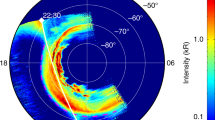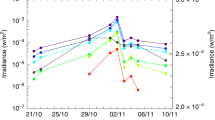Abstract
A FOURTH successful firing of the new Sun-pointed Skylark research rocket1 took place at 0520 G.M.T. on October 20, 1965, at Woomera, Australia. The flight was designated SL 306 and on board were instruments prepared by Culham Laboratory and University of Leicester Groups for study of the short-wave-length emission of the Sun. This note presents a number of new X-ray photographs of the Sun obtained by the Leicester Group, using a camera array similar to that successfully utilized in the three earlier Skylark flights2–4. Two significant changes in the present camera were the inclusion for the first time of a Fresnel zone plate5 unit and the improvement of the geometrical resolution on one pin-hole camera unit to 1 arc min. The latter improvement was encouraged by the increased exposures available from the predicted trajectory of the new, more powerful, Raven 6A rocket motor. The zone plate was flown primarily to test its rocket-worthiness prior to use in 1966 in the first Mark II stabilized Skylark, when an attempt will be made to obtain photographs of the Sun in monochromatic radiation with resolution of 10–20 arc sec. In the present flight the zone plate camera was focused for the Lyman-α line of C VI, recently6 found to be one of the strongest short-wavelength emission lines in the solar spectrum. Full details of the camera array are given in Table 1.
This is a preview of subscription content, access via your institution
Access options
Subscribe to this journal
Receive 51 print issues and online access
$199.00 per year
only $3.90 per issue
Buy this article
- Purchase on Springer Link
- Instant access to full article PDF
Prices may be subject to local taxes which are calculated during checkout
Similar content being viewed by others
References
Cope, P. G., J. Brit. Interplan. Soc., 19, 285 (1964).
Russell, P. C., Nature, 205, 684 (1965).
Russell, P. C., Nature, 206, 281 (1965).
Unpublished photographs from SL 303, flown on April 9, 1965.
Möllenstedt, G., von Grote, K. H., and Jonsson, C., in X-ray Optics and Microanalysis, edit. by Pattee, Cosslett and Engstrom, 73 (1963).
Tousey, R., Austin, W. E., Purcell, J. D., and Widing, K. G., Ann. d'Astrophys., 28, 760 (1965).
Preliminary Reports on Solar Activity, 22nd and 29th October (1965) (World Data Center A, Boulder, Colorado).
Pounds, K. A., and Russell, P. C., paper read at COSPAR Meeting, Mar del Plata, Argentina, May 1965 (to be published in Space Research, 6, 1966).
Blake, R. L., Chubb, T. A., Friedman, H., and Unzicker, A. E., Ann. d'Astrophys., 28, 583 (1965).
Author information
Authors and Affiliations
Rights and permissions
About this article
Cite this article
RUSSELL, P., POUNDS, K. Improved Resolution X-ray Photographs of the Sun. Nature 209, 490–491 (1966). https://doi.org/10.1038/209490a0
Issue Date:
DOI: https://doi.org/10.1038/209490a0
This article is cited by
-
A survey of coronal holes and their solar wind associations throughout sunspot cycle 20
Solar Physics (1978)
-
An investigation of the structure of coronal active regions
Solar Physics (1973)
-
Solar photography in the extreme ultraviolet
Solar Physics (1969)
-
Systematic photometry of XUV solar images
Solar Physics (1969)
Comments
By submitting a comment you agree to abide by our Terms and Community Guidelines. If you find something abusive or that does not comply with our terms or guidelines please flag it as inappropriate.



